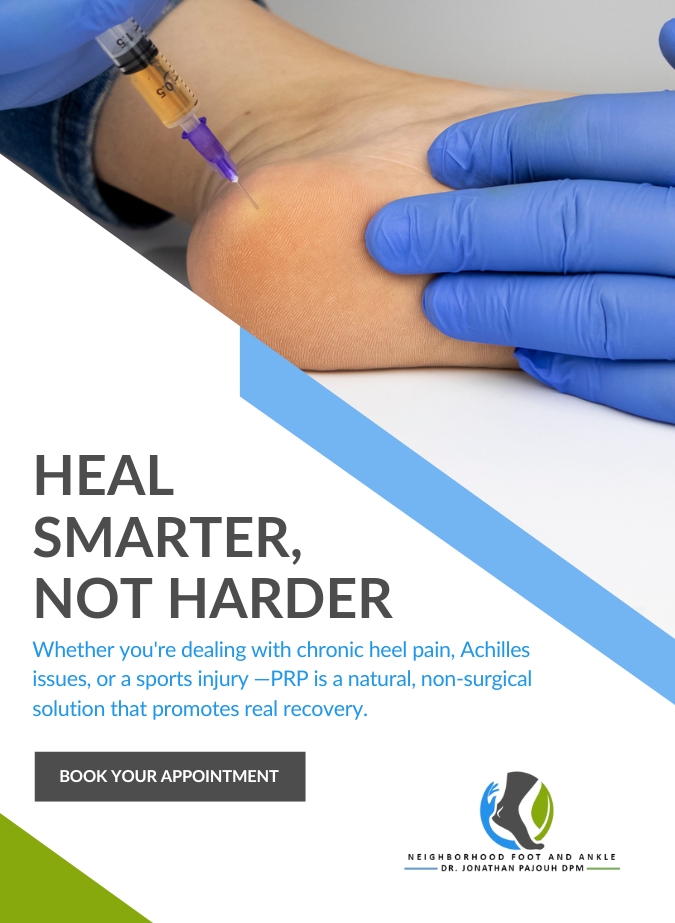
Heal Smarter: How PRP Therapy Transforms Foot and Ankle Recovery
Did you know that chronic foot and ankle injuries can sideline your physical activities for months, significantly impacting your quality of life? Understanding how to approach these injuries wisely is crucial. In this blog post, we’ll delve into the transformative effects of PRP (Platelet-Rich Plasma) therapy, a groundbreaking non-surgical treatment that naturally enhances healing for various common and complex conditions affecting your feet and ankles. From chronic heel pain to sports injuries, feel empowered with insights about how PRP therapy could facilitate a faster recovery while minimizing downtime. Let’s explore how to heal smarter, not harder!
Understanding PRP Therapy
Platelet-Rich Plasma (PRP) therapy is an innovative procedure that utilizes a patient’s own blood components to promote healing and tissue regeneration. By concentrating the platelets in your blood, which are rich in growth factors, we can leverage the body’s natural healing processes.
What Is Involved in PRP Therapy?
The PRP therapy process typically involves the following steps:
1. Blood Collection: A small amount of your blood is drawn, similar to a regular blood test.
2. Centrifugation: The blood is placed in a centrifuge, which spins at high speeds to separate the components of the blood. This separates the red blood cells from the plasma, allowing us to concentrate the platelets.
3. Injection: The concentrated platelet-rich plasma is then injected into the treatment area—be it your heel, Achilles tendon, or affected joints.
How PRP Therapy Works
When injected into the injured area, PRP releases growth factors and bioactive proteins that stimulate healing. This intensifies the body’s response to injury by:
- Enhancing the proliferation of cells involved in tissue repair.
- Reducing inflammation, providing relief from pain and discomfort.
- Speeding up the overall recovery process, leading to improved function and mobility.
Benefits of PRP Therapy for Foot and Ankle Injuries
PRP therapy presents several compelling advantages:
1. Natural Healing: As it uses your own blood, the risk of allergic reactions or complications is minimal.
2. Minimally Invasive: Unlike traditional surgical interventions, PRP injections are less invasive and often require only local anesthesia.
3. Quick Recovery: Our patients often experience a faster return to their normal activities with PRP, enabling quicker recuperation.
4. Reduced Pain: The anti-inflammatory properties of growth factors in PRP therapies can reduce pain effectively.
Who Can Benefit from PRP Therapy?
PRP therapy is ideal for a variety of conditions, including but not limited to:
- Chronic Heel Pain: Conditions like plantar fasciitis can be notoriously stubborn; PRP offers a potential solution.
- Achilles Tendonitis: Athletes and active individuals often suffer from Achilles issues; PRP is known to promote healing in tendon injuries.
- Bunion Pain: Many patients experience relief from bunion pain through PRP therapy, thanks to the growth factors aiding tissue repair.
- Sports Injuries: Whether it’s a strain or sprain, PRP therapy can help athletes get back in the game quicker.
- Diabetic Foot Ulcers: PRP can play a critical role in the healing process for patients suffering from diabetic complications affecting the feet.
The PRP Therapy Procedure
To better understand what to expect, here’s a comprehensive breakdown of the PRP therapy procedure:
1. Initial Consultation: You’ll meet with your physician to discuss your specific condition and determine if PRP therapy is right for you.
2. Preparation: The healthcare provider will prepare for the blood draw and injection; ensuring a sterile environment is paramount.
3. Blood Draw: A small amount of blood will be collected from your arm.
4. Processing: The drawn blood will be processed in the centrifuge to isolate the plasma rich in platelets.
5. Injection: After preparing the PRP, it will be injected into the affected area using ultrasound guidance if needed, providing improved accuracy.
6. Recovery Time: Following the procedure, you may encounter minor soreness where the injection occurred, but additional downtime is typically minimal.
What to Expect During Recovery
After undergoing PRP therapy, it’s crucial to manage your recovery effectively:
- Post-Procedure Activity: You may need to avoid aggravating activities for a few days while the healing process begins. Light activity might be recommended based on your individual case.
- Pain Management: Some discomfort post-injection is common, and you may apply ice or take over-the-counter medications as directed by your doctor.
- Follow-Up Visits: Regular check-ins will be important to assess your healing process and make adjustments where necessary.
PRP Success Rates
While outcomes can vary based on the individual and their specific conditions, numerous studies show that PRP therapy has a high rate of success in promoting healing. It has been particularly effective in patients who did not find relief from conservative treatments such as physical therapy or medications.
Is PRP Therapy Right for You?
Considering the regenerative and healing capabilities of PRP therapy, it might be the answer for those struggling with ongoing foot and ankle issues. However, to determine its suitability for your specific needs:
- Thoroughly consult with a medical expert who specializes in sports medicine or podiatry.
- Discuss your medical history, current conditions, and potential benefits and risks.
Final Thoughts: Embracing a Smarter Healing Approach
By choosing PRP therapy, you’re investing in your body’s natural healing power. This innovative treatment offers a promising path for those grappling with chronic foot and ankle injuries that might have held them back for too long. Instead of opting for more invasive surgical procedures, think about how PRP can facilitate your recovery journey more effectively.
Book Your Appointment
Ready to explore the transformative potential of PRP therapy for your foot and ankle issues? Contact Us – Reconstructive Podiatric Foot & Ankle Surgeon, Dallas TX
